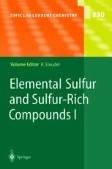Search
Search Results
-
Structural Aspects of Spin Crossover. Example of the [FeIILn(NCS)2] Complexes
The interplay between the spin crossover and the structural properties of the complexes in the solid state is still under investigation. In...
-
Modeling the hydration of proteins at different pH values
The atomic coordinates of proteins, for example, of the enzyme lysozyme as a small model protein, can be used for calculating analytically the exact...
-
Cycloaddition Reactions of Group 6 Fischer Carbene Complexes
Group 6 heteroatom-stabilised carbene complexes (Fischer carbene complexes) offer many interesting possibilities to build rings (carbocycles and...
-
Photoinduced Reactions of Metal Carbenes in Organic Synthesis
The photoinduced reactions of metal carbene complexes, particularly Group 6 Fischer carbenes, are comprehensively presented in this chapter with a...
-
Thio-, Seleno-, and Telluro-Carboxylic Acid Esters
This chapter reviews studies into the preparation of thio-, seleno-, and telluro-carboxylic acid esters (referred to thiol, selenol, and tellurol...
-
Nanoscale Lattice Fluctuations in Cuprates and Manganites
Local lattice displacements giving a nanoscale inhomogeneous pattern due to mesoscopic phase separation in the correlated transition metal...
-
Essential Heterogeneities in Hole-Doped Cuprate Superconductors
An expanded review of recent pertinent experiments in hole-doped cuprates is presented [1]. These include photoemission, inelastic neutron...
-
The Construction and Operation of Anion Sensors: Current Status and Future Perspectives
This chapter is intended to provide an insight into the construction and operation of anion sensing devices, rather than the chemistry of anion...
-
Total Internal Reflection Fluorescence Microscopy in Single Molecule Nanobioscience
Recent development in total internal reflection fluorescence microscopy (TIRFM) has made it possible to directly monitor the behaviors of...
-
Fluorescence Lifetime Imaging Microscopy (FLIM)
Fluorescence lifetime imaging microscopy (FLIM) is a technique to map the spatial distribution of nanosecond excited state lifetimes within...
-
Palladium-Catalyzed Cross-Coupling Reactions of Unactivated Alkyl Electrophiles with Organometallic Compounds
For many years, unactivated alkyl electrophiles that contain β hydrogens were generally regarded as unsuitable partners for palladium-catalyzed...
-

-
Macrocycle Synthesis Through Templation
This review highlights the major advances over the last 5 years in the templated synthesis of carbon-based macrocycles. With selected examples, it...
-
Recent Advances in the Chemistry of Difunctionalized Organo-Phosphorus and -Sulfur Compounds
Recent results related to the synthesis and reactivity of organocompounds substituted by both phosphorus and sulfur functional groups are reviewed....
-
Donor-Acceptor Complexes of Low-Coordinated Cationic π-Bonded Phosphorus Systems
Cationic low-coordinated π-bonded phosphorus compounds add Lewis donors, such as amines or phosphines. In contrast to the trigonal bipyramide formed...
-
Biologically Produced Sulfur
Sulfur compound oxidizing bacteria Sulfur compound oxidizing bacteria produce sulfur as an intermediate in the...
-
Specific Structures Enabled by Metallocene Catalysis in Polyethenes
This chapter briefly describes the history of metallocene polymerisation catalysts. The behaviour of metallocenes, particularly in copolymerisation...
-
Environmental Degradation of Polyethylene
The environmental degradation of polyethylene proceeds by synergistic action of photo- and thermo-oxidative degradation and biological activity....
-
Ligand Field Theoretical Considerations
The phenomenon of the thermal spin transition, as observed for octahedral transition metal complexes having a d...
-
Special Classes of Iron(II) Azole Spin Crossover Compounds
In this chapter, selected results obtained so far on Fe(II) spin crossover compounds of 1,2,4-triazole, isoxazole and tetrazole derivatives are...
